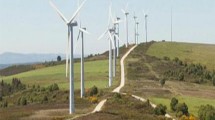Abstract
In any region, to begin generating electricity from wind energy, it is necessary to determine the 1-year distribution characteristics of wind speed. For this aim, a wind observation station must be constructed and 1-year wind speed and direction data must be collected. For determining the distribution characteristics, the collected data must be statistically analyzed. The continuity and reliability of the data are quite important for such studies on the days when possible faults can occur in any part of the observation unit or on days when, the system is on maintenance, it is not possible to record any data. In this study, it is assumed that the station had not worked at some randomly chosen days and that for these days no data could be recorded. The missing data are predicted using the data that were recorded before and after fault or maintenance by an adaptive neuro-fuzzy inference system (ANFIS). It is seen that ANFIS is successful for such a study.









Similar content being viewed by others
References
Hocaoglu FO, Kurban M (2005) A wind turbine design for generating electricity from wind speed, EVK’2005, first energy quality and efficiency conference, pp 124–128 (in Turkish)
Hocaoglu FO, Kurban M (2005) A solar panel control system design to improve the efficiency. Solar energy systems symposium and exhibition, Mersin, pp 62–69 (in Turkish)
Kaygusuz KS (2003) Renewable energy potential and utilization in Turkey. Energy Conversion Manag 44:459–478
Volkan S, Ediger VS, Kentel E (1999) Renewable energy potential as an alternative to fossil fuels in Turkey. Energy Conversion Manag 40:743–755
Zadeh LA (1975) The concept of a linguistic variable and its application to approximate reasoning. Information science part I: 8 199–249, part II: 8 301–357, part III: 9 43–80
Hocaoglu FO, Senturk S, Oysal Y (2005) A neuro-fuzzy approach to relative humidity forecasting and an application for Eskisehir region, 4st Turkish statistics conference, Antalya, pp 192–194 (in Turkish)
Kurban M, Hocaoglu FO (2006) The construction of hybrid (wind–solar) power plant model by determining the wind and solar potential in the Iki Eylul Campus of A.U., Anadolu University scientific research project, project no. 2004/040258 (in Turkish)
Jang JSR (1993) ANFIS: adaptive–network-based fuzzy inference systems. IEEE Trans Syst Man Cybern 23:665–685
Kecman V (2001) Learning and soft computing: support vector machines, neural networks and fuzzy logic models. MIT Press, Cambridge
Haykin S (1999) Neural networks. Prentice-Hall International, New York
Author information
Authors and Affiliations
Corresponding author
Rights and permissions
About this article
Cite this article
Hocaoglu, F.O., Oysal, Y. & Kurban, M. Missing wind data forecasting with adaptive neuro-fuzzy inference system. Neural Comput & Applic 18, 207–212 (2009). https://doi.org/10.1007/s00521-008-0172-8
Received:
Accepted:
Published:
Issue Date:
DOI: https://doi.org/10.1007/s00521-008-0172-8




